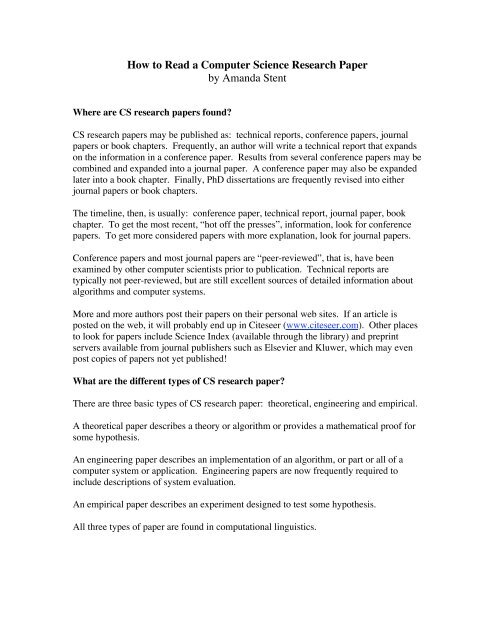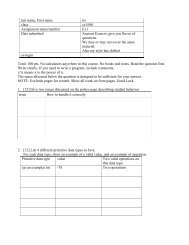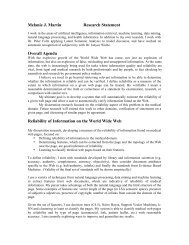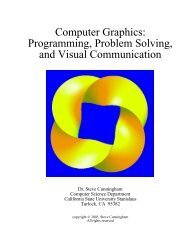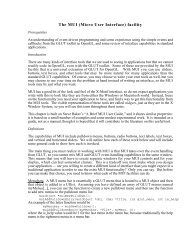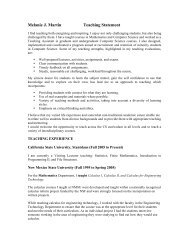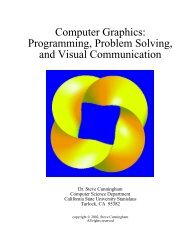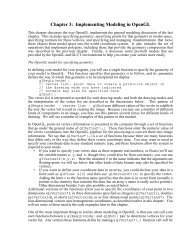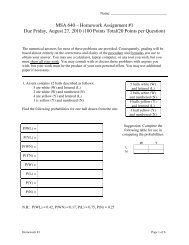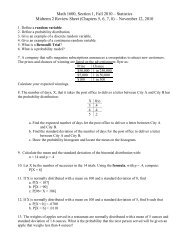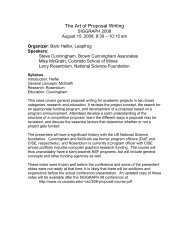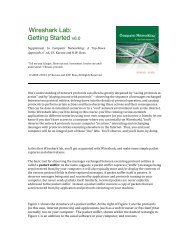How to Read a Computer Science Research Paper by Amanda Stent
How to Read a Computer Science Research Paper by Amanda Stent
How to Read a Computer Science Research Paper by Amanda Stent
- No tags were found...
You also want an ePaper? Increase the reach of your titles
YUMPU automatically turns print PDFs into web optimized ePapers that Google loves.
<strong>How</strong> <strong>to</strong> <strong>Read</strong> a <strong>Computer</strong> <strong>Science</strong> <strong>Research</strong> <strong>Paper</strong><strong>by</strong> <strong>Amanda</strong> <strong>Stent</strong>Where are CS research papers found?CS research papers may be published as: technical reports, conference papers, journalpapers or book chapters. Frequently, an author will write a technical report that expandson the information in a conference paper. Results from several conference papers may becombined and expanded in<strong>to</strong> a journal paper. A conference paper may also be expandedlater in<strong>to</strong> a book chapter. Finally, PhD dissertations are frequently revised in<strong>to</strong> eitherjournal papers or book chapters.The timeline, then, is usually: conference paper, technical report, journal paper, bookchapter. To get the most recent, “hot off the presses”, information, look for conferencepapers. To get more considered papers with more explanation, look for journal papers.Conference papers and most journal papers are “peer-reviewed”, that is, have beenexamined <strong>by</strong> other computer scientists prior <strong>to</strong> publication. Technical reports aretypically not peer-reviewed, but are still excellent sources of detailed information aboutalgorithms and computer systems.More and more authors post their papers on their personal web sites. If an article isposted on the web, it will probably end up in Citeseer (www.citeseer.com). Other places<strong>to</strong> look for papers include <strong>Science</strong> Index (available through the library) and preprintservers available from journal publishers such as Elsevier and Kluwer, which may evenpost copies of papers not yet published!What are the different types of CS research paper?There are three basic types of CS research paper: theoretical, engineering and empirical.A theoretical paper describes a theory or algorithm or provides a mathematical proof forsome hypothesis.An engineering paper describes an implementation of an algorithm, or part or all of acomputer system or application. Engineering papers are now frequently required <strong>to</strong>include descriptions of system evaluation.An empirical paper describes an experiment designed <strong>to</strong> test some hypothesis.All three types of paper are found in computational linguistics.
<strong>How</strong> call I tell whether a research paper is good before I read it?The short answer <strong>to</strong> that is, it is always best <strong>to</strong> read it. <strong>How</strong>ever, every year thousands ofpapers are published <strong>by</strong> the ACM, IEEE, AAAI, ACL and other professional societies.You can’t read them all!Usually, you want <strong>to</strong> read a research paper either because you have a specific problemyou need <strong>to</strong> solve, or <strong>to</strong> keep up with your field. In either case, as you read researchpapers you will begin <strong>to</strong> get an idea of which venues and which researchers publish goodresearch in your area. Citeseer can help with this, as it tracks citations (so that you canfind out what papers other researchers consider <strong>to</strong> be excellent or at least popular).In addition <strong>to</strong> learning what are good publication venues in your field and checkingcitations, you can sometimes tell if a paper is likely <strong>to</strong> be good <strong>by</strong> looking for structuralclues in the paper itself. Here are some indica<strong>to</strong>rs of a good research paper:1) The problem the paper addresses is clearly stated, both in the abstract and early onin the paper itself. The technical importance and broader impacts of the paper aredescribed.2) The paper includes a clear description of the experiment, system or theory theproblem addresses. This is usually the second section of the paper.3) The paper describes and analyzes the results of the work described (eitherexperimental or evaluation results).4) The authors have some sound, non-trivial ideas for future work. This usuallyappears at the end of the paper.5) Related work is described and cited correctly. You can get an idea of this <strong>by</strong>looking at the list of references at the end of the paper.If you know that a researcher has been working in an area for awhile, that is usually anindica<strong>to</strong>r that the research is sound; however, do not underestimate the contributions ofpeople new <strong>to</strong> a field or the impact of politics on research.<strong>How</strong> should I read a research paper?First, skim the paper <strong>to</strong> check that it has the elements described above (clear problemstatement, clear description of method or system, clear presentation of results, appropriatecitation of related work). At the end of this quick skim you should be able <strong>to</strong> write downthe type of the paper (theoretical, engineering or empirical), the area of computer sciencethe paper is about, and the problem the paper addresses.Now read the introduction carefully, looking for the problem statement, theoreticalimportance and broader impact. Sometimes related work is also addressed in theintroduction. Consider: are the author’s claims reasonable and realistic? Do the authorspresent evidence that they know why they are doing this piece of research? Do they havean idea of the larger picture?
Now read the methods section carefully (this section might be called “experiment” or“system description”, or may involve statement of theorems and their proofs). Askyourself:1. Can you think of counter-examples for examples given?2. Is the approach clearly described? Can you outline the steps or summarize theapproach?3. Does the work address the problem stated earlier in the paper?4. Does the approach seem <strong>to</strong> require unreasonable amounts of human guidance?5. Does the approach seem objective?<strong>Computer</strong> science papers are often written in English <strong>by</strong> non-native speakers of English.Syntactic errors or awkwardness of phrasing do not indicate that the research is bad; youshould try distinguish between the writing style and the research itself. If you getconfused, you can reread or write down your questions <strong>to</strong> check in other work <strong>by</strong> thesame authors.If, at the end of this section, you think the approach is sound (even if you disagree withit!), read the results, evaluation or analysis section. (If there is no such section and thepaper dates from post-1995, there is a problem!) Ask yourself:1. Do these results address the problem stated at the start of the paper?2. Do the authors use commonly-accepted terminology and methods?3. What is the conclusion of the research?Finally, look at the conclusions and future work (last section of the paper). These can begood sources of <strong>to</strong>pics for your own research.A brief note about older research papers: computer science is a rapidly evolving fieldand is still very young compared <strong>to</strong> many of the fields closest <strong>to</strong> it (mathematics,engineering). <strong>Research</strong> papers that date from before the 1990s may appear very differentfrom newer papers. They may be more speculative, include less evaluation or noevaluation, and typically involve the use of much less data. There are very practicalreasons for this (slower computers, less data available). These are not reasons <strong>to</strong> discountthese papers!<strong>How</strong> can I remember the papers I have read?I strongly recommend that you make an electronic file for your own bibliography. ABibTeX file is a good idea. After you read a paper, if you think it is worth remembering,write an entry for that paper in your bibliography file. You should note: authors’ names,paper title, how paper was published (conference proceedings, journal etc.), date ofpublication and page numbers (if possible). Add a 2-3 sentence description of the paperin which you summarize for yourself the problem addressed <strong>by</strong> the paper, the solutionproposed or results learned, and the future work proposed.Some people publish their bibliographies, see: http://liinwww.ira.uka.de/bibliography/.


